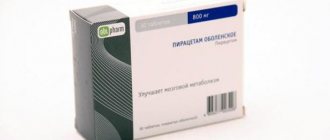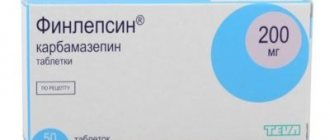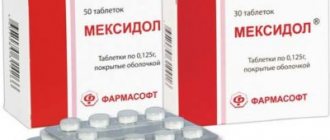Pharmacological properties of the drug Lucetam
The active component of Lucetam is piracetam, a cyclic derivative of γ-aminobutyric acid. Piracetam is a nootropic drug that has a positive effect on metabolic processes and blood circulation in the brain, improving cognitive processes such as learning ability, memory, attention, and mental performance. The drug affects the central nervous system in various ways: by changing the speed of propagation of excitation in the brain, improving metabolic processes in nerve cells, improving microcirculation, affecting the rheological characteristics of the blood and without having a vasodilating effect. Improves connections between the cerebral hemispheres and synaptic conduction in neocortical structures. Piracetam inhibits platelet aggregation and restores the elasticity of the erythrocyte membrane, reduces the adhesion of erythrocytes. At a dose of 9.6 g, it reduces the level of fibrinogen and von Willibrand factors by 30–40% and increases bleeding time. Piracetam has a protective and restorative effect in cases of impaired brain function due to hypoxia and intoxication. Piracetam reduces the severity and duration of vestibular nystagmus. After oral administration, piracetam is quickly and almost completely absorbed, the maximum concentration is reached 1 hour after administration. Bioavailability is about 100% after taking a single dose of 2 g. The volume of distribution of piracetam is about 0.6 l/kg body weight. The half-life of the drug from blood plasma is 4–5 hours and 8.5 hours from cerebrospinal fluid; this period increases with renal failure. Does not bind to blood plasma proteins and is not metabolized in the body. 80–100% of piracetam is excreted unchanged by the kidneys through renal filtration. The renal clearance of piracetam in healthy volunteers is 86 ml/min. The pharmacokinetics of piracetam does not change in patients with liver failure. Piracetam penetrates the blood-brain and placental barriers and membranes used in hemodialysis. In animal studies, piracetam selectively accumulates in the tissues of the cerebral cortex, mainly in the frontal, parietal and occipital lobes, in the cerebellum and basal ganglia. IV administration When administered IV, the effect of piracetam begins quickly. Bioavailability - 100%. The maximum concentration in the cerebrospinal fluid is achieved within 2-8 hours. The half-life from the blood plasma is 4-5 hours, from the cerebrospinal fluid - 6-8 hours. High concentrations of the drug are determined in the cerebral cortex and cerebellum, in some basal ganglia. The drug penetrates the placenta and into breast milk and is not metabolized in the body. Piracetam is excreted by the kidneys mainly unchanged. Within 24–30 hours after a single dose, 90–100% of the administered dose of piracetam is eliminated. About 1–2% are detected in feces.
Practical patient experience
Reviews from patients who are already taking Lucetam will help those who are just thinking about using the product form their opinion.
The closer the session got, the less energy I had left for studying. I decided that it was vitamin deficiency and went to the pharmacist at the nearest pharmacy. She also asked me about my health and advised me to take Lutsetam.
After taking the first tablet, I didn’t notice any results and was very upset, but decided to finish the package of the drug. And I didn’t regret it.
Literally 7-10 years passed and I began to notice myself that I began to think better in class. As a result, I passed the session with flying colors, which is a huge credit to the pills. Therefore, I recommend it to anyone who has problems with remembering and concentrating.
Victoria, student
I have been suffering from vegetative-vascular dystonia for several years now. Especially in the summer, when it is very hot outside, I feel completely “broken”, dizziness, apathy, and absent-mindedness occur. I contacted a neurologist who advised me to take Lucetam injections.
But, since I don’t really like all kinds of injections, we decided to try starting with tablets. I drank them three times a day, 800 mg, for 2 months. And after this time, all negative symptoms disappeared. Now I can say that my health is simply amazing! For prevention, I plan to take another course soon.
Anna
Indications for use of the drug Lucetam
Tablets Symptomatic treatment for psychoorganic syndrome in elderly patients with memory loss, dizziness, decreased concentration and general activity, mood changes, behavioral disorders, gait disorders, including Alzheimer's disease and senile dementia of the Alzheimer's type. Therapy for the consequences of stroke (chronic stage of ischemic stroke), traumatic brain injury. As part of complex therapy for low learning ability in children with psychoorganic syndrome. For the treatment of cortical myoclonus both in mono- and complex therapy. Solution for injection The drug Lucetam is used to treat patients with different types of dementia, that is, with loss or deterioration of memory, loss of concentration and/or agility in movements, diseases of the nervous system, especially caused by cerebrovascular disorders in elderly and senile people, with aphasia as a result of cerebral hypoxia, cortical myoclonus, organic mental syndrome in elderly people. It improves intellectual functions such as thinking, learning, and mastering previously learned habits. Used as an adjuvant in the treatment of symptoms arising from brain damage and operations on it (for example, dizziness, involuntary movements of the eyeballs, loss of the ability to speak and/or write). Lucetam can be used to treat deterioration of cognitive functions in people who abuse alcohol. The drug can also be used in them to treat symptoms of alcohol withdrawal.
Expert opinion
The opinion of practitioners will also be interesting.
Mothers often come to me with complaints about their child’s poor performance at school. Additional classes and tutors do not help. As the teachers themselves say, such children cannot concentrate on the educational material and end up getting bad grades.
I always recommend Lucetam to such parents. But it is worth noting that it must be taken throughout the entire study period. This is the only way to get the desired effect. I choose the dose based on the age and individual characteristics of the child.
Svetlana, pediatrician
Lucetam is a nootropic drug that has proven itself well in my practice. It quickly normalizes the functioning of the brain after injuries, intoxication or hypoxia.
It's not bad for older people either. But for them you need to carefully select the dosage, since they often have many concomitant diseases that need to be taken into account when making a prescription.
Victor, neurologist
Use of the drug Lucetam
Tablets Use internally. Daily dose - 30-160 mg/kg body weight, frequency of administration - 2-4 times a day, with meals or on an empty stomach; The tablets should be taken with liquid (water, juice). For symptomatic treatment of chronic psychoorganic syndrome, depending on the severity of symptoms, 4.8 g / day is prescribed (12 tablets of 400 mg or 6 tablets of 800 mg or 4 tablets of 1200 mg) for the first few weeks, followed by a reduction in the maintenance dose within 1.2– 2.4 g/day (3–6 tablets 400 mg or 11/2–3 tablets 800 mg or 1–2 tablets 1200 mg). For the consequences of a stroke (chronic stage), 4.8 g/day is prescribed. For difficulties in perception for persons with brain injuries, the initial dose is 9–12 g/day, maintenance dose is 2.4 g/day. The duration of treatment is at least 3 weeks. For children over 7 years of age, 3.3 g/day is prescribed to correct reduced learning ability. The treatment is long-term, throughout the entire academic year. For cortical myoclonus, treatment begins with 7.2 g/day, every 3–4 days the dose is increased by 4.8 g/day until a maximum dose of 24 g/day is reached. Therapy is continued throughout the entire period of the disease. Every 6 months the dose is gradually reduced or the drug is discontinued. In order to prevent an attack, the dose is reduced gradually, by 1.2 g every 2 days. If there is no effect or in case of insignificant therapeutic effect, treatment is stopped. Daily doses for children aged:
- 1 year–3 years – 400 mg/day;
- 3–7 years – 400–800 mg/day;
- 7–12 years – 400–2000 mg/day;
- 12–16 years – 800–2400 mg/day.
Dosing for patients with impaired renal function Since Lucetam is excreted from the body by the kidneys, the drug should be prescribed according to the following treatment regimen.
Degree of renal failure | Creatinine clearance, ml/min | Dosing |
| Norm | 80 | Usual dose |
| Lightweight | 50–79 | 2/3 of the usual dose in 2–3 doses |
| Average | 30–49 | 1/3 of the usual dose in 2 divided doses |
| Heavy | ≤30 | 1/6 about the usual dose once |
| Terminal stage | – | Contraindicated |
Patients with impaired liver function do not require dose adjustment. Solution for injection Treatment can be carried out over several weeks, months and even years (the tablet form of Lucetam is used). The duration of therapy depends on the patient's condition and response to it. The drug is administered intravenously as an infusion. Solvents used:
- 0.9% sodium chloride solution;
- 5; 10; 20% fructose solution;
- 5; 10; 20% glucose solution;
- 5% levulose solution;
- 10% solution of Dextran 40 in 0.9% solution of sodium chloride;
- 6% solution of Dextran 100 in 0.9% solution of sodium chloride;
- Ringer solution;
- Ringer's solution Lactate;
- solution Mannitol - Dextran;
- 6% solution of hydroxethyl starch (HES).
Adults
Typically, the initial dose is 2400 mg/day, maintenance - 1200–2400 mg/day. The initial and maintenance doses are distributed in several doses (for example, 2 doses per day). The daily dose is 4800 mg.
- Patients during the period of alcohol withdrawal can receive 12 g, then they are transferred to a maintenance dose of 2400 mg/day;
- patients with sudden contraction of muscles of cerebral origin: initial dose - 2-4 g / day, gradually increasing over several weeks to a daily dose - 9-12 g;
- organic mental syndrome in elderly people: 4800 mg/day for several weeks with the following reduction to a maintenance dose of 1200–2400 mg/day;
- cerebrovascular lesions, cognitive deficits after head injuries: daily dose of 9–12 g in the first 2 weeks, then a maintenance dose of 2400 mg/day for at least 3 weeks.
Children aged 8–12 years with childhood dyslexia The maximum daily dose is 3200 mg of Lucetam or 0.03–0.16 g/kg body weight. Doses for patients with renal impairment
Creatinine clearance, ml/min | Serum creatinine, mg | Dose |
| 40–60 | 1, 25–1,7 | Usual adult dose |
| 20–40 | 1, 7–3,0 | 1/4 about the usual dose for adults |
Elderly patients can take the drug in doses prescribed for adults without their correction.
Release form, composition and price
"Lucetam 1200" can be found in pharmacies in the form of white biconvex film-coated tablets. They are odorless and have the “E 243” mark engraved on one side.
The main active ingredient is piracetam. As you might have guessed, it is contained in each tablet in the amount of 1200 mg. However, there is also “Lucetam” 800 mg and 400 mg. It’s just that, depending on the patient’s condition and the course of his disease, different dosages may be prescribed, and it is more convenient to take one tablet containing 1200 mg of piracetam than three 400 mg tablets.
In addition to the active ingredient, the composition also contains povidone K-30 and magnesium stearate, plus various components that form the shell.
The drug, by the way, is inexpensive. “Lucetam 1200 mg,” instructions for use of which will be discussed below, costs about 120 rubles. Accordingly, the less active ingredient in the tablets, the cheaper they are.
Side effects of the drug Lucetam
Tablets There are isolated reports of side effects from the gastrointestinal tract: nausea, vomiting, diarrhea, abdominal and stomach pain; from the nervous system: dizziness, headache, ataxia, imbalance, exacerbation of epilepsy, insomnia; from the psyche: excitement, anxiety, nervousness, hallucinations, increased sexuality, rarely - drowsiness and depression; from the skin: dermatitis, itching, skin rashes, swelling. Solution Complaints such as nervousness, irritability, fear, anxiety, aggressiveness, sleep disturbance, increased excitability and increased motor activity most often occur in older people, as well as with daily administration of the drug in doses exceeding 2400 mg. Nausea, dizziness, headache, hand tremors, increased sexuality and allergic reactions are rare.
Overdose
Considering the quantities in which this drug is prescribed, one can guess that it is non-toxic. During the entire medical practice, only one case was registered when, due to “Lucetam,” a person developed dyspeptic symptoms - pain in the lower abdomen and diarrhea with blood impurities. And that’s because the patient took the solution in the amount of 75 g (!).
If poisoning does occur, it is necessary to urgently induce vomiting, rinse the stomach, and then carry out symptomatic therapy. Hemodialysis is allowed - it will give approximately 50-60 percent effectiveness.
Special instructions for the use of the drug Lucetam
Due to the effect of piracetam on platelet aggregation, caution is required when prescribing the drug to patients with impaired hemostasis, during major surgical operations, or to patients with symptoms of severe bleeding. When treating patients with cortical myoclonus, abrupt interruption of therapy should be avoided, as this may cause resumption of attacks. During long-term therapy in the elderly, regular monitoring of renal function parameters is recommended; if necessary, dose adjustment is carried out depending on the results of a creatinine clearance study. Considering the possible side effects, the patient should be careful when driving vehicles and operating machinery. Penetrates through the filter membranes of hemodialysis machines. Pregnancy and lactation period Animal studies have not revealed any negative effects on the embryo and its development, including in the postnatal period; piracetam did not affect the course of pregnancy and childbirth. There is no experience in using the drug for treatment in pregnant women. Piracetam penetrates the placental barrier and into breast milk. The concentration of the drug in the blood of newborns reaches 70–90% of its concentration in the mother’s blood. Except in special circumstances, Lucetam is not used during pregnancy. You should refrain from breastfeeding during treatment with the drug.
Contraindications
Lucetam solution is contraindicated in the following diseases and situations:
- Psychomotor agitation at the time of use;
- Hemorrhagic stroke;
- Huntington's chorea;
- Severe chronic renal failure (creatinine clearance less than 20 ml/min);
- Use in pediatric practice under 3 years of age;
- During pregnancy and breastfeeding.
In case of previously identified allergic reactions to piracetam, pyrrolidone derivatives or other components of the drug.
Lucetam should be used with caution in cases of hemostasis disorders, major surgical interventions, severe bleeding, and chronic renal failure (with a moderate decrease in creatinine clearance of 20-80 ml/min).
Drug interactions Lucetam
When combined with thyroid hormones (T3+T4), increased irritability, disorientation and sleep disturbance are possible. There was no interaction with clonazepam, phenytoin, phenobarbital, or sodium valproate. Piracetam in high doses (9.6 g/day) increased the effectiveness of acenocoumarol in patients with venous thrombosis: a significant decrease in the level of platelet aggregation, fibrinogen level, Villibran factors, blood viscosity and blood plasma was noted. The possibility of changing the pharmacodynamics of piracetam under the influence of other drugs is low, since 90% of the drug is excreted unchanged in the urine. In vitro, piracetam does not inhibit cytochrome P450 isoforms CYP1A2, 2B6, 2C8, 2C9, 2C19, 2D6, 2E1 and 4A9/11 at a concentration of 142; 426; 1422 mcg/ml. Therefore, metabolic interaction with drugs that undergo biotransformation by these enzymes is unlikely. Taking piracetam at a dose of 20 mg/day did not change the maximum and curve of the concentration level of antiepileptic drugs in the blood serum (carbamazepine, phenytoin, phenobarbital, valproate) in patients with epilepsy. In patients with epilepsy receiving appropriate therapy for this reason, it may be necessary to adjust the treatment and conduct a course of IV therapy with Lucetam. Concomitant use of the drug and alcohol consumption did not affect the level of piracetam concentration in the blood serum - the concentration of alcohol in the blood serum did not change when taking 1.6 g of piracetam.
Reviews
It is important to pay attention to them too. The patient reviews left about “Lucetam 1200” are positive. And here are the comments people who have taken these pills write most often:
- Blood pressure problems disappear, dizziness and other symptoms disappear. Some argue that a few weeks were enough to achieve this result.
- Elderly people whose health has seriously deteriorated with age are literally getting a second wind. And many are incredibly surprised by this - they say, vigor appears, activity increases, energy returns.
- Memory is normalized, mood, sleep, and ability to concentrate improve. Over time, memory strengthens and performance increases.
- The drug also helps with osteochondrosis. It not only relieves pain, but also helps stop hair loss, which many patients associate with this particular disease.
- Over time, productivity can improve. According to the patients' feelings, the nervous system seems to stop wearing out. The desire to constantly take breaks from work also disappears, and irritability disappears. People notice that they can again work calmly and fulfill their work obligations without discomfort.
And there are dozens of similar comments. But all people mention in their reviews: the instructions for using “Lucetam 1200 mg” must be followed! This medication is not suitable for everyone. But if the doctor decides that it will help you, then it is possible that you will be among those lucky people who consider Lutsetam a real panacea.
Analogs
Finally, it is worth listing drugs that can be an alternative to the tablets in question. "Lucetam 1200" has many analogues, but if for some reason the original medicine cannot be found, then only a doctor can select a replacement. Doing this on your own is dangerous.
An alternative would be one of the following:
- "Piracetam."
- "Memotropil."
- "Nootropil"
- "Pyratropil."
- "Pirabene".
- "Escotropile."
- "Noocetam."
- "Pyramem."
- "Cerebrill."
- “Nootobril.”
- "Stamin."
These are drugs that are completely similar to “Lucetam” in terms of the active substance. But there are also medications that are similar in action. This:
- "Tiocetam".
- "Vinpotropil."
- "Phenotropil".
- "Fezam."
- "Omaron."
- "Combitropil".
- "Fescetamus."
- "Pantogam".
- "Encephabol."
- "Pantocalcin".
- "Picamilon".
- "Bilobil."
- "Nooklerin."
And this is not the entire list of products that can become an alternative to Lucetam 1200 mg. The instructions for using the tablets are similar, but there are always some differences. And the doctor will tell his patient about them, who will select an alternative.





